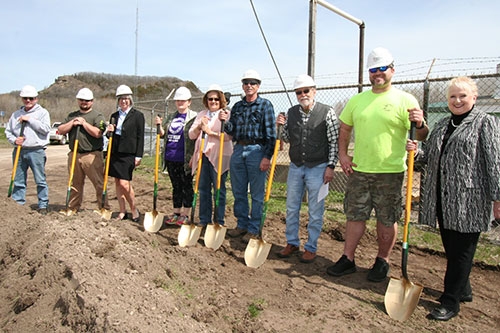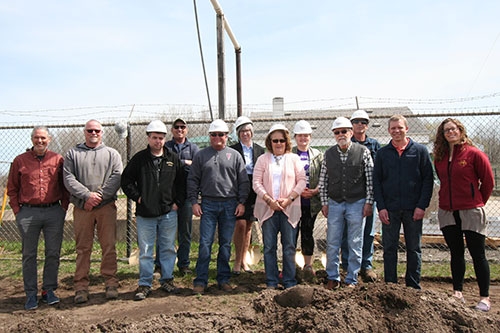You are here
Home ›City of New Albin breaks ground for new algae wheel wastewater treatment facility

City of New Albin breaks ground at Wastewater Treatment Facility site ... Pictured above during the Wastewater Treatment Facility ground-breaking ceremony in New Albin, from left to right: Steve Meiners, City Superintendent; Jake Reburn, City Worker; Maria Stahl, Council Member; Alexie Grotegut, Council Member; Debra Crane, Council Member; Dale Mauss, Council Member; George Blair, Council Member and Mayor Pro Tem; Josh Dreps, past Mayor; Debra Stantic, City Clerk. Photo by Julie Berg-Raymond.

Algae Wheel Wastewater Treatment Facility to be completed in 18 months ... The City of New Albin broke ground at the future site of the city’s Wastewater Treatment Plant May 4. Council members and maintenance employees attended the event along with contractors and other individuals instrumental in planning this project. Pictured above, from left to right, front row: Daniel Johnson Ph.D., Chief Technology Officer at OneWater Inc.; Scott Linberg, Superintendent, Wapasha Construction; Patrick Doyle, Vice President, Wapasha Construction; Tom Peplinski, President, Wapasha Construction; Debra Crane, Council Member; George Blair, Council Member and Mayor Pro Tem; Lucas Elsbernd, Senior Project Engineer, Fehr Graham Engineering & Environmental and Ashley Christensen, Regional Economic Development Specialist, Upper Explorerland Regional Planning Commission. Back row: Kevin Mracek, President, Mracek Plumbing, Heating, & Electrical; Maria Stahl, Council Member; Alexie Grotegut, Council Member; Dale Mauss, Council Member. Photo by Julie Berg-Raymond.
by Julie Berg-Raymond
The City of New Albin broke ground on its long-awaited new wastewater treatment plant Wednesday, May 4. Among those tossing the first ceremonial shovels of dirt was George Blair, Council member and Mayor Pro Tem, the guiding force behind a project that has been many years in the planning.
Attending the event were council members, contractors, city maintenance employees and other people instrumental in bringing the project to fruition – by, for example, conducting research and securing funding.
“This wastewater project has been a long time between inception and now,” Blair told those gathered for the ground-breaking. “A mid-19th century map was discovered that revealed several Indian Mounds were previously located on the site of the original wastewater plant. As the new plant will replace the old plant, extenuating circumstances arose that had to be resolved under the law. The Iowa Department of Natural Resources (IDNR) had never in the past dealt with a similar problem, so the resolutions required were very difficult and (it) took an inordinate amount of time to reach an accord.” Ultimately, he said, “a path forward was found and the IDNR followed the established rules while allowing the City Council to choose an innovative system called the Algaewheel, developed by OneWater Inc.”
Present at the event was Lucas Elsbernd, Senior Project Engineer with Fehr Graham Engineering & Environmental, of Manchester, and the manager and lead design engineer for this project. “To me, the most exciting aspects of this include knowing that it will allow the City of New Albin to meet permit limits, and that we are installing a relatively new technology for wastewater treatment that is a good fit for the city,” he said. He anticipates the project being complete in about 18 months.
In a prepared statement he distributed at the ceremony, Blair described the Algaewheel system as “a series of paddle wheels that float in large, precast concrete tanks. The floating wheels are reminiscent of the paddle wheel boats that plied the Big Muddy back when Mark Twain navigated it before the Civil War. The algaewheels, however, are much smaller than their riverboat ancestors, though similar in design. Each wheel is three feet in diameter by one and a half feet wide. With five wheels side-by-side on a shaft and 15 shafts per tank, each large tank holds 75 wheels. Both tanks together total 150 wheels that are enclosed in a greenhouse.
“The floating wheels in both tanks rotate due to the bubbles created by the submerged blowers that drive the paddles on the wheels. As the sun shines through the greenhouse and strikes the algae that forms on each wheel, photosynthesis occurs. In a symbiotic chemical reaction with bacteria present in the wastewater, the algae converts ammonia to nitrates that can then be safely released into the Mississippi River. The whole system has very little friction, requiring less energy to operate, thereby reducing energy costs. Harnessing additional assistance from the sun, the City plans to further reduce energy costs by installing an adjacent solar array.”
“(This) is an efficient and well-planned system that will serve our community very well,” Blair said. “The birds, the fish and the ecosystem will benefit from the right decisions we the people made.”

